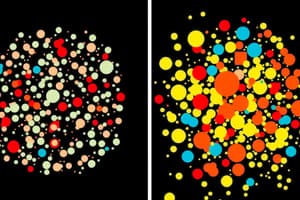Podcast
Questions and Answers
Flashcards
Clustering
Clustering
Grouping similar data objects into clusters based on their characteristics.
Cluster
Cluster
A collection of data objects that are similar to each other within the same group and dissimilar to objects in other groups.
Cluster Analysis
Cluster Analysis
The process of finding similarities between data objects and grouping them into clusters.
Unsupervised Learning
Unsupervised Learning
Signup and view all the flashcards
Intra-class similarity
Intra-class similarity
Signup and view all the flashcards
Inter-class similarity
Inter-class similarity
Signup and view all the flashcards
Similarity Metric
Similarity Metric
Signup and view all the flashcards
Distance Function
Distance Function
Signup and view all the flashcards
High-Dimensional Clustering
High-Dimensional Clustering
Signup and view all the flashcards
Subspace Clustering
Subspace Clustering
Signup and view all the flashcards
Scalability
Scalability
Signup and view all the flashcards
Attribute Types
Attribute Types
Signup and view all the flashcards
Constraint-based Clustering
Constraint-based Clustering
Signup and view all the flashcards
Outlier Detection
Outlier Detection
Signup and view all the flashcards
Hierarchical Clustering
Hierarchical Clustering
Signup and view all the flashcards
Preprocessing
Preprocessing
Signup and view all the flashcards
Clustering Application
Clustering Application
Signup and view all the flashcards
Vector Quantization
Vector Quantization
Signup and view all the flashcards
Document Clustering
Document Clustering
Signup and view all the flashcards
What is clustering?
What is clustering?
Signup and view all the flashcards
What are applications of clustering?
What are applications of clustering?
Signup and view all the flashcards
What is unsupervised learning?
What is unsupervised learning?
Signup and view all the flashcards
What is the goal of clustering?
What is the goal of clustering?
Signup and view all the flashcards
What are the criteria for good clustering?
What are the criteria for good clustering?
Signup and view all the flashcards
What factors influence clustering quality?
What factors influence clustering quality?
Signup and view all the flashcards
How does clustering aid in outlier detection?
How does clustering aid in outlier detection?
Signup and view all the flashcards
What are the benefits of pre-processing for clustering?
What are the benefits of pre-processing for clustering?
Signup and view all the flashcards
What is vector quantization?
What is vector quantization?
Signup and view all the flashcards
What is the role of clustering in document retrieval?
What is the role of clustering in document retrieval?
Signup and view all the flashcards
What is document clustering?
What is document clustering?
Signup and view all the flashcards
What is the goal of constraint-based clustering?
What is the goal of constraint-based clustering?
Signup and view all the flashcards
What are the challenges of clustering?
What are the challenges of clustering?
Signup and view all the flashcards
What is scalability in relation to clustering?
What is scalability in relation to clustering?
Signup and view all the flashcards
How does clustering help with data compression?
How does clustering help with data compression?
Signup and view all the flashcards
What is incremental clustering?
What is incremental clustering?
Signup and view all the flashcards
What is the significance of interpretability in clustering?
What is the significance of interpretability in clustering?
Signup and view all the flashcards
What is the importance of usability in clustering?
What is the importance of usability in clustering?
Signup and view all the flashcards
What is the significance of 'High Quality' in clustering?
What is the significance of 'High Quality' in clustering?
Signup and view all the flashcards
What is the significance of 'Others' in clustering challenges?
What is the significance of 'Others' in clustering challenges?
Signup and view all the flashcards
What are the benefits of using clustering as a pre-processing step?
What are the benefits of using clustering as a pre-processing step?
Signup and view all the flashcards
What is the significance of 'good enough' in clustering?
What is the significance of 'good enough' in clustering?
Signup and view all the flashcards
What is the significance of 'similar enough' in clustering?
What is the significance of 'similar enough' in clustering?
Signup and view all the flashcards
Study Notes
Clustering Techniques
- Clustering groups objects based on their similarities.
- Clustering algorithms are categorized into:
- Partitioning methods
- Hierarchical methods
- Density-based methods
- Grid-based methods
- Model-based methods
- K-means and K-medoids are popular partitioning methods.
- AGNES, DIANA, Birch, and Chameleon are common hierarchical methods.
- DBSCAN, OPTICS, and DENCLUE are density-based techniques.
- STING and CLIQUE are grid-based methods, with CLIQUE specifically for subspace clustering.
Distance Measures
- Single linkage: The smallest distance between elements in different clusters.
- Complete linkage: The largest distance between elements in different clusters.
- Average linkage: The average distance between all pairs of elements in different clusters.
- Centroid: The distance between the centroids (means) of two clusters.
- Medoid: The distance between the medoids of two clusters.
Cluster Measures
- Centroid: The center of a cluster.
- Radius: The square root of the average distance from any data point to the centroid.
- Diameter: The square root of the average mean squared distance between all pairs of points.
Clustering Validation
- The Hopkins statistic measures cluster tendency; values of >0.5 suggest clustering potential.
- The Davies-Bouldin Index assesses the quality of clustering, with lower values indicating better clustering. The DB value is based on the ratio of intra-cluster variance to the inter-cluster distance.
- The Dunn Index also measures clustering quality. This is calculated by taking the minimum inter-cluster distance divided by the maximum intra-cluster distance. A higher Dunn Index indicates better-quality clustering.
- Silhouette coefficient: Provides a measure of how similar a data point is to its own cluster compared to other clusters.
Hierarchical Clustering (AGNES and DIANA)
- AGNES (Agglomerative Nesting): A bottom-up hierarchical clustering method where clusters begin as individual data points and iteratively merge the most similar clusters.
- DIANA (Divisive Analysis): A top-down hierarchical clustering method where a single cluster is initially formed, and then it repeatedly splits the cluster that has the largest average intra-cluster distance.
Density-Based Clustering (DBSCAN and OPTICS)
- DBSCAN (Density-Based Spatial Clustering of Applications with Noise): Finds dense clusters of arbitrary shapes by considering local density.
- OPTICS (Ordering Points To Identify the Clustering Structure): Also a density-based method similar to DBSCAN, ordering the data points to identify cluster structure by core-distance and reachability-distance.
K-Means Variations
-
PAM (Partitioning Around Medoids): Robust to outliers compared to K-means, since it uses medoids instead of means.
-
CLARA (Clustering LARge Applications): An improved algorithm of PAM, used for large dataset, samples data to perform clustering.
-
CLARANS (Clustering Large Applications based on Randomized Search): Improves on earlier sampling-based methods, more sophisticated in handling outliers and clusters of various sizes.
Studying That Suits You
Use AI to generate personalized quizzes and flashcards to suit your learning preferences.




